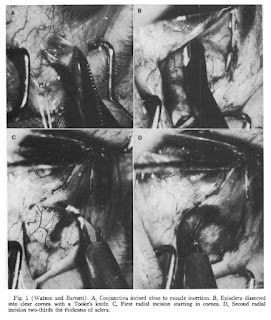DR. YUSRA TANVEER
P.G. SCHOLAR, DEPT OF DERMATOLOGY
AJMAL KHAN TIBBIYA COLLEGE AND HOSPITAL
ALIGARH MUSLIM UNIVERSITY, ALIGARH, INDIA
Some types of glaucoma such as pseudo-exfoliative
glaucoma (PXG) resemble certain integumentary disorders. In PXG a dandruff-like
material is seen covering the ocular surfaces. The exact composition and
pathogenesis of this pseudo-exfoliative material is unknown. However, the
resemblance of this material to dandruff makes us wonder if glaucoma could be
associated with dermatological conditions.
There appears to be a lack of studies in
the literature regarding this association. Kang et al. reported a survey of
79,102 American women and 41,205 American men older than 40 years of age and at
risk for glaucoma. They also reviewed the participants’ histories of skin
cancer such as basal cell carcinoma (BCC), squamous cell carcinoma (SCC), and
non-melanoma skin cancer. They found a 40% higher risk of PXG associated with a
history of any non-melanoma skin cancer. This association was observed even
with 4- and 8-year lags in non-melanoma skin cancer history. Also, the
non-melanoma skin cancer association was stronger in patients younger than 65
than those older than 65. They also found that those living in northern
latitudes had a significantly stronger association than those residing in
southern latitudes. [1]
Another study was conducted by Ahmadpour et
al. at the Mashhad University of Medical Sciences, Iran, to compare the
frequency of dermatological manifestations between patients with PXG and those
with primary open-angle glaucoma (POAG). The study involved 21 patients from
the PXG group and 26 patients from the POAG group.
All PXG patients and 24 (92.3%) POAG
patients had at least one abnormal dermatological finding (P = 0.495). [2]
The most common dermatological
manifestations in patients with PXG were seborrheic dermatitis, dry skin, and
cherry angioma. Other dermatologic manifestations of these patients included
idiopathic guttate, hypomelanosis on the trunk and limbs, xeroderma pigmentosome
and severe aging, lentigo maligna, and cafe au lait macules. In patients with
POAG, the most common dermatological findings were seborrheic dermatitis,
cherry angioma, and dry skin. Other specific manifestations seen in these
patients included androgenic alopecia, telogen effluvium due to acetazolamide,
nail-biting, pityrosporum folliculitis, sebaceous hyperplasia, nail fungal
infection, alopecia areata, photosensitivity, macular amyloidosis, lipoma, and
venous lake.
The most common dermatological condition
found in all glaucoma patients was seborrheic dermatitis which was seen in 57.1–61.5%individuals.
12 patients with PXG and 16 with POAG had seborrheic dermatitis (P =
0.775). One patient in the PXG group and two in the POAG group had seborrheic
findings on both head and face.
Eleven patients in the PXG group and seven
in the POAG group had dry skin manifestations, mainly in their extremities.
Although the frequency of dry skin was almost twice in those with PXG compared
to the POAG group, the difference failed to reach the level of statistical
significance (P = 0.130). Lentigines were observed in five PXG patients,
while none of the POAG patients had this finding (P = 0.013).
There was no significant difference in the
frequency of nevus and angiomas between the two groups. Also, no association
between gender or patients’ age and the frequency of dermatologic
manifestations (P > 0.154 for all comparisons) was found.
The frequency of dermatologic findings did
not correlate with visual acuity, intra-ocular pressure, or cup-disc ratio (CDR)
(P > 0.142 for all comparisons).
It is not clear how glaucoma is associated
with skin disorders. One hypothesis is that glaucoma patients because of their
age, lower socioeconomic status, and poor vision are unable to take care of
themselves, leading to an increased frequency of these skin disorders. On the
contrary, dermatological conditions could contribute directly to glaucoma, such
as that seen in PXG. Also, corticosteroids used to treat skin diseases can
contribute to steroid-induced glaucoma.
STEROID-INDUCED GLAUCOMA: https://ourgsc.blogspot.com/search?q=steroid
Therefore, it may be advantageous to assess
glaucoma patients for any dermatological conditions especially if they are
being planned for surgery as any infections could be a potential risk. Also,
steroid-induced glaucomas may confound the diagnosis unless specifically asked
for as the patients may be reluctant to reveal their dermatological conditions
themselves.
REFERENCES:
- Kang
JH, VoPham T, Laden F, Rosner BA, Wirostko B, Ritch R, Wiggs JL, Qureshi A, Nan
H, Pasquale LR. Cohort Study of Nonmelanoma Skin Cancer and the Risk of
Exfoliation Glaucoma. J Glaucoma. 2020 Jun;29(6):448-455. doi:
10.1097/IJG.0000000000001496. PMID: 32487970; PMCID: PMC7317065.
- Ahmadpour
F, Nahidi Y, Daneshvar R. Dermatological Findings in Glaucoma Patients:
Comparison Between Pseudoexfoliative and Primary Open-angle Glaucoma. J
Ophthalmic Vis Res 2022;17:479–485.


































